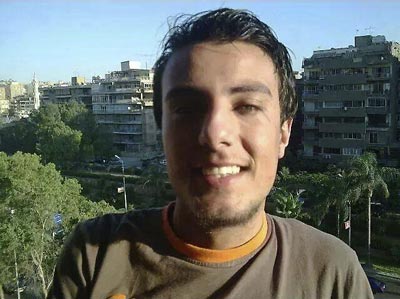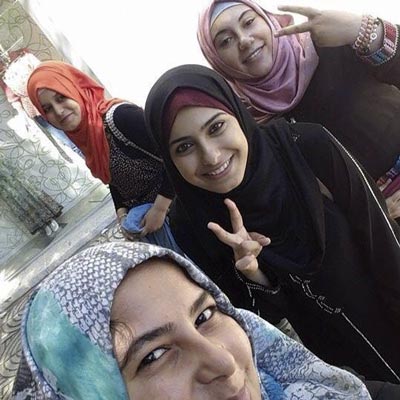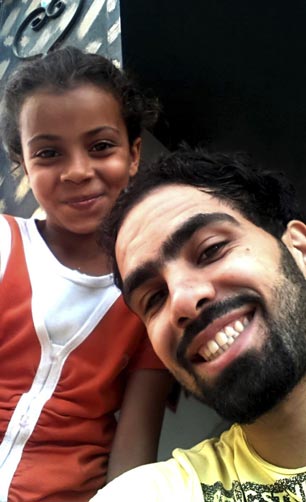Part of the Series
Gaza on Fire
With nothing but poverty, trauma and political strife in the news for the Gaza Strip, the future for its 1.8 million inhabitants seems unremittingly bleak. One thing I have learned from my many visits to Gaza is that the people are amazingly resilient. But how much more can they stand?
Nearly 64 percent of Palestinians in Gaza are age 25 or younger. Their future is Gaza’s future. These young people have lived through three deadly assaults on their homes; most have never been able to leave the tiny, densely crowded Strip; and youth unemployment is estimated to be as high as 50 percent.
This is a look at the possibilities going forward, as illustrated by the stories of three different youth. Which of their stories predominates will depend on the response of the international community, both to the ongoing suffocation and destruction that have characterized Gaza since the imposition of the Israeli blockade in 2007, and its official adoption by Egypt in 2013. Although the high-level international participants in this month’s Reconstructing Gaza conference said all the right things about the need to end the blockade of Gaza and reunify Palestinians, those words have been said before, and there is very little faith on the ground that talk will transform into action.
Ahmad Asfour
 (Photo: Abdelrahman Asfour)I first became acquainted with Ahmad (then 19) and his family in 2010, when I met his father, Samir, at a solidarity demonstration for Palestinian prisoners in Israeli jails outside Gaza’s office of the International Red Cross. The ordeal that brought him there began the year before, during the “First Great War on Gaza,” Operation Cast Lead.
(Photo: Abdelrahman Asfour)I first became acquainted with Ahmad (then 19) and his family in 2010, when I met his father, Samir, at a solidarity demonstration for Palestinian prisoners in Israeli jails outside Gaza’s office of the International Red Cross. The ordeal that brought him there began the year before, during the “First Great War on Gaza,” Operation Cast Lead.
Ahmad and four teenaged cousins were hit by fragments from a missile fired by an Israeli drone, while sitting on the front porch of their home east of Khan Younis, in the southern region of the Gaza Strip. The fragments lodged in his left eye, broke his jaw, shattered his teeth, severely lacerated both hands and right thigh, destroyed his genitals, and damaged his pancreas and intestines.
When he was eventually referred to a hospital in Jerusalem for advanced treatment, Ahmad was subjected to lengthy and brutal interrogation at the Erez crossing into Israel. In his weakened state, he “confessed” to charges of supporting terrorism and was imprisoned. (Read his full story.) Only with the intervention of lawyers and several human rights groups was he released back to his family after three years in prison.
“When Ahmad was finally released to us, his health was so bad, because he didn’t get proper treatment in jail,” recalls his father, Samir, through an interpreter. “He never felt good about life after that, and he didn’t fit back in with society well.”
Ahmad is not alone. According to Konstantina Bougonikolou, psychologist and medical coordinator with Doctors Without Borders, continuous exposure to violence and conflict can have a long-term, damaging effect on children and youth, even if it does not show immediately. “Their life takes a wrong turn, and it’s very hard to take them back. . . . They often adopt reckless or compulsive behavior and don’t hesitate to throw themselves in dangerous situations. They won’t be afraid to be engaged in situations that might lead to their death.”
That certainly was true for Ahmad. On Sept. 6, he and three of his cousins (the same ones who were wounded with him in 2009) were among more than 400 refugees who believed the promises of unscrupulous smugglers and boarded a boat they hoped would sail them to asylum in Italy.
According to Samir Asfour, his son and nephews traveled to Egypt after receiving permission to enter for further medical treatment. Ahmad’s cousins were the first to hear about the boat to Italy, and Ahmad could not resist; he longed to live someplace where he could live without fear and receive the expensive medical treatment he so desperately needed to control his injury-induced diabetes. The cost for a spot on the boat: $2,200. Ahmed had brought $1,500 for his treatments, and borrowed the rest from relatives in Egypt.
“He told me he wanted to go to Italy by this boat, and I said, ‘no! It’s too dangerous,'” Samir told me with a sadness that spread to my own heart. “I talked to him many times to try to convince him, but he told me he was dying now. He had no hope. He had to try.”
On Sept. 10, the boat sank, apparently after being rammed by the smugglers who had arranged the trip or a competing group. More than half of the 450 to 500 passengers were Palestinians from Gaza; only eight of them survived. Ahmad and his cousins were not among them.
Postscript: With Gaza’s Youth Advocacy League reporting that the percentage of young people hoping to leave Gaza has increased from 35 percent last year to 85 percent following the recent assault, concern is high that even more will follow in Ahmad’s footsteps. Euro-Mid Observer for Human Rights, a Geneva- and Gaza-based nonprofit, has partnered with my new organization (New Generations for Palestinian Children and Youth) to post billboards across the Strip warning them of the dangers of illegal migration.
Maram Rezeq
 (Photo: Maram Rezeq)At 18, Maram Rezeq is the third-oldest child among eight in a family in central Gaza that struggles to get by. Her father left the Strip several months before the latest war to find work, and meanwhile, her mother tutors to bring in a little income. (I am the “American mother” of two of her brothers studying in the United States and stay with the Rezeq family when I visit Gaza.)
(Photo: Maram Rezeq)At 18, Maram Rezeq is the third-oldest child among eight in a family in central Gaza that struggles to get by. Her father left the Strip several months before the latest war to find work, and meanwhile, her mother tutors to bring in a little income. (I am the “American mother” of two of her brothers studying in the United States and stay with the Rezeq family when I visit Gaza.)
Throughout the worst of the fighting, Maram and I would chat on Facebook about her fears and uncertainties – including when she was receiving strange calls on her mobile phone that she thought could be the Israeli army – because Maram didn’t want to burden her already-stressed mother.
Maram is smart, but her only hope of attending university was to earn a scholarship abroad. Shortly before the Israeli assault began, she was offered a “full-ride” scholarship in Turkey to study business administration and international relations. Throughout the traumatic weeks that followed, Maram questioned her ability to survive, to get out and to perform well if she was able to leave.
“Maram,” I kept telling her, “You have to believe. If you don’t believe in yourself, who will?” But even I became discouraged when her start date drew closer and she contracted typhoid fever, was told Egypt had banned exits to Turkey and received only silence from Israel about a departure that way.
And then Maram rallied. Fortified by antibiotics, the diminutive teenage girl decided to take her chances with the Egyptian border guards and simply show up at the crossing.
Two days later, she had made it to the dorm that will be her home for at least the next five years – in Izmir, Turkey. Maram had been allowed out of Gaza (likely helped by the US visa from her year at an American high school, which had not yet expired), bought the next ticket for Turkey and made it all the way to her dormitory, on her own. With most of her fellow scholarship winners still stuck in Gaza, “It was a miracle,” everyone seemed to agree.
“It was the most scary, crazy and wonderful experience I’ve ever had,” she told me later. “And you know what? I never knew I could be so strong.”
I had been so worried about Maram, and now I know I don’t need to be. Like Gaza, she has proven – to herself and others – that she can bounce back after almost anything. Yet her achievement meant that Gaza had lost one of its best and brightest.
“Shark” (Ahmed Al-Ghraiz)
 (Photo: Ahmed Al-Ghraiz)At 25, a resident of one of the poorest refugee “camps” in Gaza (Nuseirat) and unable to find a job as the nurse he trained to be, Ahmed Al-Ghraiz seems likely to have a tale as sad as the “other Ahmad.” But he doesn’t, and this is the story that makes me most optimistic.
(Photo: Ahmed Al-Ghraiz)At 25, a resident of one of the poorest refugee “camps” in Gaza (Nuseirat) and unable to find a job as the nurse he trained to be, Ahmed Al-Ghraiz seems likely to have a tale as sad as the “other Ahmad.” But he doesn’t, and this is the story that makes me most optimistic.
Ahmed and his brothers Mohammed and Jarule grew up initially in Saudi Arabia. Mohammed began watching breakdancing on YouTube as a teenager; the “resistance” form of art first pioneered by American blacks in the ’80s appealed to his dancer’s soul.
When the family moved to Gaza in 2004 to reunite with relatives, Mohammed started the Strip’s first breakdance crew, the Camps Breakerz. His brothers Ahmed and Jarule were among the first members. At first, it was rough. When I interviewed the guys for a video series in 2011, they talked of discrimination within Gaza, as well as out. Breakdance is a Western art that is widely considered “un-Islamic” in the conservative religious culture.
Today, however, despite several painful turnovers in the crew’s primary performers (including the departure of Mohammed, who now is studying nursing in the United States), the group is flourishing, not in sophistication of equipment or skill (they lack basic resources such as team T-shirts), but in acceptance. Now led by Shark (Ahmed’s “bboy” name), the performers risked their lives to travel to schools used as temporary shelters to entertain homeless children, and now have begun training their first cohort of little “bgirls.”
Yes, Shark wants to travel outside of Gaza (the crew is trying to raise funds now to perform in France). But he will, he says, always come back.
“I dont wanna leave Gaza,” says Shark. “I have the dance center; I have my ‘children’; I have my family; I have people around the world who love us and want us to keep dancing. (He has arranged weekly Skype chats between his students and dancers around the globe.) And I have a larger mission: to keep art alive here, in the hearts of the kids. I have everything that really matters right here.”
The most recent war has left both the Strip’s physical state and civic morale the worst I’ve seen. The destruction is overwhelming and the despair is palpable. But the “heart” of Palestinian culture and independence still beats, albeit with a struggle, in Gaza. It’s up to international activists everywhere to join with its youth to keep that beat going.
We’re not backing down in the face of Trump’s threats.
As Donald Trump is inaugurated a second time, independent media organizations are faced with urgent mandates: Tell the truth more loudly than ever before. Do that work even as our standard modes of distribution (such as social media platforms) are being manipulated and curtailed by forces of fascist repression and ruthless capitalism. Do that work even as journalism and journalists face targeted attacks, including from the government itself. And do that work in community, never forgetting that we’re not shouting into a faceless void – we’re reaching out to real people amid a life-threatening political climate.
Our task is formidable, and it requires us to ground ourselves in our principles, remind ourselves of our utility, dig in and commit.
As a dizzying number of corporate news organizations – either through need or greed – rush to implement new ways to further monetize their content, and others acquiesce to Trump’s wishes, now is a time for movement media-makers to double down on community-first models.
At Truthout, we are reaffirming our commitments on this front: We won’t run ads or have a paywall because we believe that everyone should have access to information, and that access should exist without barriers and free of distractions from craven corporate interests. We recognize the implications for democracy when information-seekers click a link only to find the article trapped behind a paywall or buried on a page with dozens of invasive ads. The laws of capitalism dictate an unending increase in monetization, and much of the media simply follows those laws. Truthout and many of our peers are dedicating ourselves to following other paths – a commitment which feels vital in a moment when corporations are evermore overtly embedded in government.
Over 80 percent of Truthout‘s funding comes from small individual donations from our community of readers, and the remaining 20 percent comes from a handful of social justice-oriented foundations. Over a third of our total budget is supported by recurring monthly donors, many of whom give because they want to help us keep Truthout barrier-free for everyone.
You can help by giving today. Whether you can make a small monthly donation or a larger gift, Truthout only works with your support.